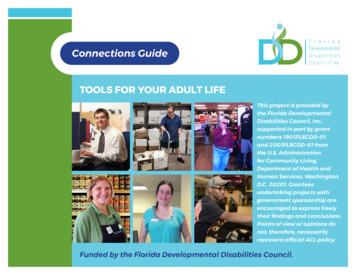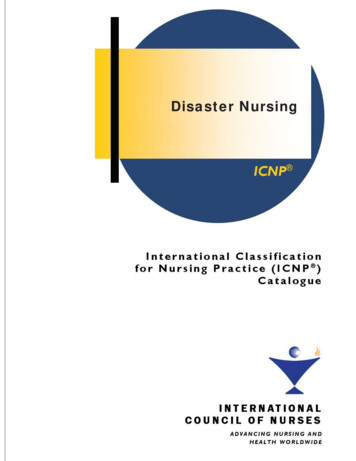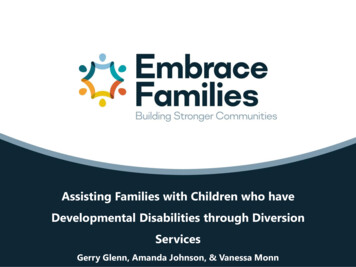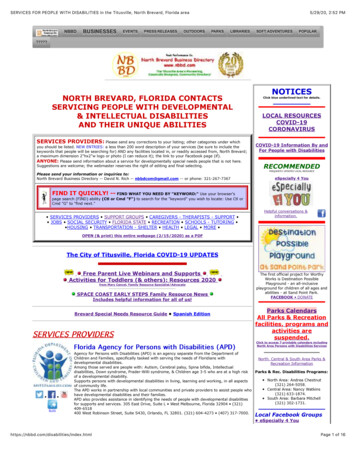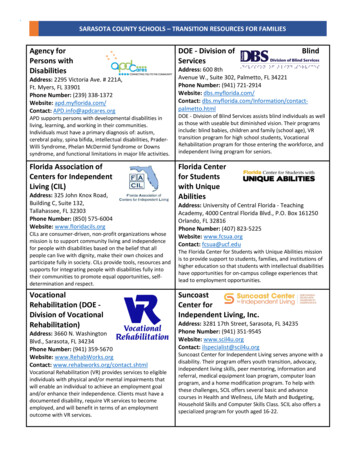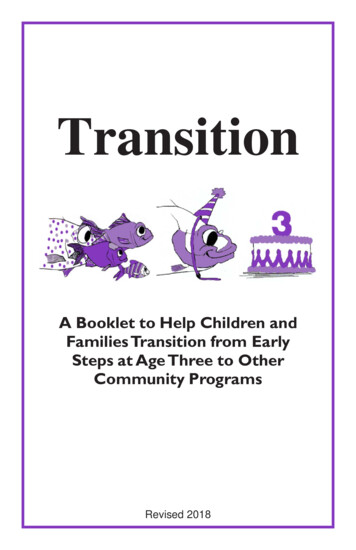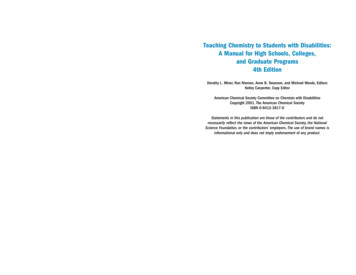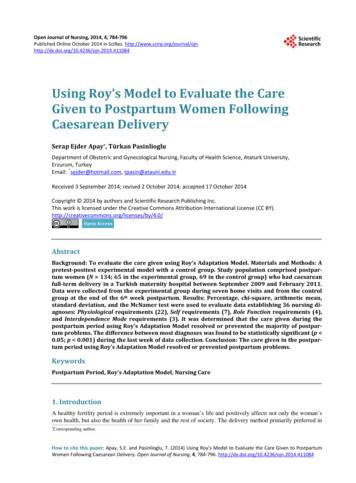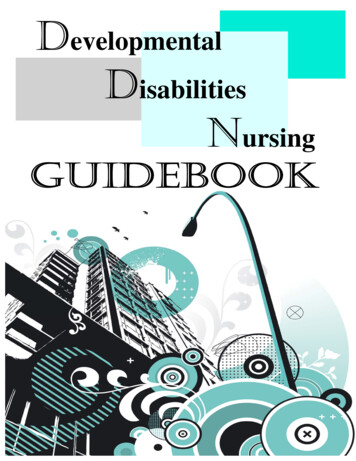
Transcription
DevelopmentalDisabilitiesNursing
DEDICATIONThe Developmental Disabilities Nursing Guide (DDNG) guide is dedicated to theDevelopmental Disabilities Nurses of the Southeastern Region of Pennsylvania who haveconsistently worked in improving the quality of health services to individuals with I/DD. Wewould also like to thank the many nurses of the Southeastern Region of Pennsylvania whohelped in the development of the DDNG and for whom we hope it will be a useful resource.Thanks to our Director, Dina McFalls, and the nurses of Philadelphia Coordinated Health Care(PCHC) for the inspiration to embark on this project and the continued motivation to complete it.We would also like to thank all of the nurses at PCHC that worked on the DDNG because itwould never have been completed without all of their help.Thanks to the Southeastern Regional Office of Mental Retardation for sharing their resources foressential background and supporting documentation. Vicki Stillman-Toomey, Regional ProgramManager, provided guidance as well as well as useful information for the guide, and GregPirmann in his A Short History of Pennhurst Center gave us not only a history of PennhurstCenter but of I/DD services in the United States as well.We would also like to acknowledge the Developmental Disabilities Nursing Association(DDNA) and the Pennsylvania Developmental Nurses’ Network (PADDNN) for recognizing theunique specialty of Developmental Disabilities (DD) Nursing and their gracious permission touse some of the materials that they had previously formulated.We also would like to thank our editor, Susannah Joyce for her objective contributions to thefinal version of the DDNG.Finally, we would like to thank Shani Jackson, Administrative Assistant, who was willing andable to handle the many changes required for this version of the DDNG to be finished.Sincerely,Jack Toomey, RN, CDDNProject Leader
DEVELOPMENTALDISABILITIESNURSINGGUIDEBOOKTable of ContentsSECTION 1: BACKGROUNDIntellectual/Developmental Disability Defined in Pennsylvania . 1Why Have a Guide? . 3A Short History of Intellectual/Developmental Disability Service System in the United States andPennsylvania . 4Selected Legislation . 10Special Health Care Requirements for Pennhurst Class Members . 11References. 15SECTION 2: ADVOCACYResource List of Advocacy Groups . 11. Southeast Region of Pennsylvania and Statewide . 12. National. 8Introduction to the ARC. 11References. 12S ECTION 3: O VERVIEW OF P ENNSYLVANIA I NTELLECTUAL /D EVELOPMENTALD ISABILITIES S ERVICE D ELIVERY S YSTEMPennsylvania Intellectual/Developmental Disabilities Service Delivery System . 11. Overview & Flow Chart of Service . 12. Pennsylvania Office of Developmental Programs Demographics. 2Southeastern Pennsylvania Intellectual/Developmental Disabilities Service System . 3Description of Community Residential Programs . 4Pennsylvania Regulations and Licensing Instruments. 5Individual Support Plan (ISP) Process. 6Agency Nurse Responsibilites within Risk Management. 7Issued July, 2009Table of Contents - i
Pennsylvania Health Care Quality Units . 8Introduction to Developmental Programs Bulletins. 10Introduction to Everyday Lives Standards. 111. Everyday Lives Standards . 12Person Centered Planning . 14References. 15S ECTION 4: P ROFESSIONAL C ERTIFICATION IN D EVELOPMENTAL D ISABILITIES N URSINGPhilosophy of Nursing Care. 1Personal Attributes of a Developmental Disabilities Nurse. 2Professional Certification in Developmental Disabilities Nursing . 3The Role of the Developmental Disabilities Nurse. 5Pennsylvania Nursing Standards and Scope of Practice . 7Developmental Disabilites Nursing Standard . 9Code of Ethics. 101. American Nurses Association. 102. Pennsylvania Developmental Disabilities Nurses’ Network . 11References. 12S ECTION 5: D ELEGATIONDelegation of Nursing Care . 1Pennsylvania Developmental Disabilities Nurses’ Network (PADDNN) Guidance on Delegation . 3Developental Disabilities Nurses Association (DDNA) Position Statement on Delegation. 7References. 11S ECTION 6: N URSING R ESPONSIBILITIESNursing Documentation . 1Nursing Orders. 2Nursing Reviews/Assessments . 3Health Promotion Activity Planning. 4Communication. 5Working with Allied Health Professionals . 9Training Requirements. 11Issued July, 2009Table of Contents - ii
Sample Health Maintenance Tracking Form . 12Developmental Disabilities: Physical and Behavioral Health Conditions . 13References. 14S ECTION 7: B EHAVIORAL H EALTHPsychotropic Medication Protocols . 1Behavioral Health: Team Review of Psychotropic Medication Form Overview . 31. Behavioral Health Team Review of Psychotropic Medication Blank Forms . 5Extrapyramidal Symptoms and Tardive Dyskinesia. 81. Recognition of Movement Disorders. 102. Abnormal Involuntary Movement Scale (AIMS) . 133. Abnormal Involuntary Movement Scale (AIMS) Sample . 144. Dyskinesia Identification System (DISCUS). 15Reference . 17S ECTION 8: H EALTH I NSURANCESPhysical Health: Health Care Insurance 101. 1Navigating the System: How to Get What People Need From Their Medical Assistance HealthMaintenance Organization . 6Behavioral Health Insurance. 11References. 12S ECTION 9: S UBSTITUTE H EALTH C ARE DECISION MAKING AND E ND OF L IFE P LANNINGSubstitute Health Care Decision Making and End of Life Planning. 1References. 3Issued July, 2009Table of Contents - iii
SECTION 10: APPENDICESA PPENDIX I:ARC Policy StatementsAdvocacyAgingHealth CareInclusionProtectionQuality of LifeRightsSelf-DeterminationSexualityA PPENDIX II:Commonwealth of Pennsylvania Mental Retardation Bulletin #00-04-05:Positive ApprochesA PPENDIX III:Community Health Review InstrumentA PPENDIX IV:Developmental Programs Bulletin ListA PPENDIX V:Everyday Lives DocumentA PPENDIX VI:Health Promotion Activity Plan (blank form)A PPENDIX VII:Health Promotion Activity Plan Sample (Seizure Disorder)A PPENDIX VIII:Hospitalization PolicyA PPENDIX IX:Nursing Assessment Sample FormA PPENDIXSpecial Services Fund for Pennhurst Class MembersX:A PPENDIX XI:Special Services Fund ApplicationA PPENDIX XII:General Guidelines for Nurses in Community Residential ProgramsSupporting People with Intellectual/Developmental Disabilities BookletA PPENDIX XIII:GlossaryIssued July, 2009Table of Contents - iv
SECTION 1BACKGROUND
Intellectual/Developmental Disability Defined in PennsylvaniaPennsylvania provides funding for intellectual/developmental disabilities (I/DD) through itsOffice of Developmental Programs (ODP). The most universally applied definition of whatconstitutes mental retardation is found in the Diagnostic and Statistical Manual IV [DSM-IV](American Psychiatric Association, 1994). Pennsylvania’s definition of eligibility for mentalretardation services differs from the definition in the DSM-IV in only one significant way.According to Pennsylvania the age of onset of mental retardation must occur before the 22ndbirthday, concurring with federal funding criteria for Pennsylvania’s Medicaid waivers. TheDSM-IV states that the age of onset of mental retardation must occur prior to the individual’s18th birthday.Pennsylvania’s definition of mental retardation and the one outlined in the DSM-IV agree in thetwo most important criteria for a diagnosis. According to both definitions a person must have:1. A significantly sub average intellectual functioning as determined by an individuallyadministered IQ test (on most standardized tests this would be an IQ score of 70 or below)and2. Concurrent impairments in adaptive functioning as determined by a standardized adaptivebehavior scale. Impairments must be in at least two of the following areas: CommunicationSelf CareHome LivingSocial/Interpersonal SkillsUse of Community ResourcesSelf Direction Academic SkillsWorkLeisureHealthSafetyAt least one percent of the U.S. population has been diagnosed with a developmental disability,an estimate which is considered to be conservative (Developmental Disabilities NursesAssociation Study Guide for Developmental Disabilities Nursing, p.1). The criteria for adiagnosis of a developmental disability are broader than those used for a diagnosis of mentalretardation. Keep in mind that everyone with mental retardation has a developmental disability,but not everyone with a developmental disability has mental retardation. However, people withmental retardation often have one or more concurrent developmental disabilities. For this reasonit is useful to look at what constitutes a developmental disability.The Developmental Disabilities Assistance and Bill of Rights Act of 1990 Public Law 10-496defines a developmental disability as a severe, chronic disability of a person who is five years ofage or older that:1. Is attributable to a mental or physical impairment or is a combination of mental and physicalimpairments2. Is manifested before the person reaches the age of 22Section 1 – Background – pg.1
3. Is likely to continue indefinitely4. Results in substantial functional limitations in three or more of the areas of major lifeactivity: self-help, receptive and expressive language, learning, mobility, self-direction,capacity for independent living, and economic self-sufficiency5. Reflects the person’s need for a combination and sequence of special interdisciplinary orgeneric care, treatment or other services that are lifelong or of extended duration and areindividually planned and coordinated, except that such term, when applied to infants andyoung children means individuals from birth to age five who have substantial developmentaldelay or specific congenital or acquired conditions with a high probability of resulting indevelopmental disabilities if services are not providedTherefore, the developmental disabilities nurse, in order to be effective in the habilitation andtreatment of people with mental retardation and/or other developmental disabilities must possessa broad range of knowledge and competencies while always being cognizant that:“Disability is a natural part of the human experience, that does not diminish the right of peoplewith developmental disabilities to live independently, to exert control and choice over their ownlives, and to fully participate in and contribute to their communities through full integration andinclusion in the economic, political, social, cultural and educational mainstream of Americansociety.” (Developmental Disabilities Assistance and Bill of Rights Act 2000, Public Law106-402, 2000)Section 1 – Background – pg.2
Why Have a Guide to Developmental Disabilities Nursing?To provide useful information about this exciting nursing specialty.Nursing has a long history of working with people with developmental disabilities, but in thepast the specialty of developmental disabilities nursing was ignored in traditional nursingeducation programs. The Developmental Disabilities Nurses Association has developed acurriculum for this area of specialization, but there is still a lack of codified information aboutwhat constitutes developmental disabilities nursing. We hope this guide will provide usefulinformation about this exciting nursing specialty.To provide a resource for nurses who are new to our specialty as well as nurses with anestablished intellectual/developmental disabilities (I/DD) practice.The guide is designed for nurses who support people with I/DD but may also be helpful toothers. The authors of the guide practice I/DD nursing in Southeastern Pennsylvania and thisdocument reflects the philosophy of the I/DD service delivery system in Pennsylvania. Theauthors also work primarily with adults living in small, integrated community residential homes,and their experience with adults is reflected in the guide. Hopefully, developmental disabilitiesnurses providing care in any settings will be able to use many of the ideas presented here.To recognize the value of the intellectual/developmental disabilities nurse.The I/DD nurse, with his/her additional training, knowledge and experience, may motivate,assist, guide, and give exceptional support to individuals with developmental disabilities andtheir support teams. The I/DD nurse recognizes the whole person who has I/DD and understandsthat many people in the I/DD system have both physical and behavioral health needs. The I/DDnurse may help to coordinate efforts among health care practitioners, and may also provide directcare. The I/DD nurse must also be able to recognize what aspects of a person’s care can beresponsibly assigned to others.To provide some background information on the how the I/DD health services system hasevolved in Pennsylvania and in the United States.The guide offers a definition of the accepted criteria for intellectual disabilities. A short historyof I/DD in the United States and Pennsylvania are offered to show how our present systemevolved. Various parts of the I/DD system in Pennsylvania and the philosophical basis for thecurrent system are presented. The reference to the Pennhurst litigation is made because of theimpact the litigation has had on how people with I/DD receive services in PA today.To provide some information on various advocacy groups involved in Pennsylvania andacross the United States.This guide offers a listing of various advocacy groups to be used as a resource.Section 1 – Background – pg.3
A Short History of the Intellectual/Developmental Disability ServiceSystem in the United States and Pennsylvania(formerly Mental Retardation Service System)Historically there were only two options for people with I/DD and developmental disabilities:their families provided total care, or they were institutionalized. In the latter half of the 20thcentury major changes evolved in philosophical and societal thinking about what people thoughtwas best for people with I/DD. This change in consciousness had roots in the civil rights andreform movements of the 1960s and 1970s, but it was also, in part, because the existing I/DDservice system began to recognize its own need for reformation.Terms like humanization, deinstitutionalization, normalization, and mainstreaming came intobeing. There was a major shift from having people stay in large isolated institutions to providingcare in small residential settings in the community. Society began to value the diversity of peoplewith I/DD.1790-1850: Making the Deviant Non-Deviant: First Attempts at RehabilitationPeople with I/DD were considered deviant, that is, different from other members of society.However, the general outlook toward people with I/DD and developmental disabilities waspositive and optimistic. Educational reformers established small residential schools for peoplewith developmental disabilities before the Civil War. These schools were seen as verysuccessful, allowing most residents to return to their communities as independent members ofsociety (White & Wolfensberger, 1969, p.5). People with I/DD were recognized as different, butthey were not seen as a burden or threat to society.Soon, however, this attitude began to change: the cause of I/DD was believed to be the result ofimmoral or unlawful behavior. The parents must have engaged in “bad behavior” to have a childwith disabilities. Society must protect these children and the best way to do this was thought tobe by removing them from the source of their “problem,” their families, and placing them inspecial schools (Developmental Disabilities Nurses Association Study Guide for DevelopmentalDisabilities Nursing, p.55). The special schools stressed discipline and moral training.1850 -1890: Let the Institutions BeginIn the 1850’s the emphasis on “special” schools changed from rehabilitation and education totraining. Academic education was abandoned for correction of bad habits and preparation forsimple jobs. The small residential schools were soon replaced by large institutions that, for themost part, soon had the goal of becoming self-supporting. The institutions used the people livingthere as direct care staff and farm hands as much as possible. Treatment could be described ascustodial at best and abusive and exploitive at worst.“Between 1880 and 1890 I/DD began to be considered a major menace and a malignant growthwhich society in self-protection had to eliminate. During this period laws were passed forbiddingmarriage and permitting or mandating sterilization and the permanent segregation of the‘feebleminded’” (White & Wolfensberger, 1969, p.6). It was also at this time that the idea oflifetime institutionalization to prevent reproduction came into being (White & Wolfensberger,Section 1 – Background – pg. 4
1969, p.6). The routine sterilization of both sexes and segregation of the sexes became the norm.These two practices were mistakenly thought of as a means to prevent all future incidences ofI/DD.1890-1910: Protect Society from the DeviantIn 1893 the first publicly owned and operated facility for the mentally retarded in Pennsylvaniawas authorized as the Western Institution for the Feebleminded, the current site of Polk StateCenter. Western Institution was established at a time when the prevailing attitude toward peoplewho were mentally retarded was shifting from pity and charity to fear and mistrust. Westerninitiated a 70-year trend of providing residential care for Pennsylvania’s retarded citizens in largeremote facilities. Prior to 1893 Pennsylvania had purchased care for people with I/DD fromElwyn Institute (a large rural institution) or admitted them to mental hospitals.Pennhurst Center was created by an act of the Pennsylvania Legislature on May 15, 1903 as the“Eastern Pennsylvania State Institution for the Feeble-Minded and Epileptic.” The Legislatureappropriated sufficient funds to erect a facility for not fewer than 500 persons and specified thatthe institution was to be, “entirely and specifically devoted to the reception, detention, care andtraining of epileptics and of idiotic and feeble-minded persons of either sex” (Pirmann, 1984).Pennhurst Center’s later notoriety would become a catalyst for radically changingPennsylvania’s I/DD service delivery system.In the early 1900s, the idea that different was detrimental was the dominant societal belief. TheBinet intelligence test was developed and imported to the United States as a way to identifypeople whose lack of normal intelligence was not readily apparent. Intelligence testing became apotent weapon against anyone society felt was unworthy. The poor, unwed mothers, prostitutes,Native Americans, and others were labeled “mentally deficient or mentally defective”(Developmental Disabilities Nurses Association Study Guide for Developmental DisabilitiesNursing, p.55).Large custodial institutions proliferated throughout the United States.1910’s: People with I/DD: The Cause of All Societal ProblemsIt did not take long to go from the belief that anyone who is different is, “detrimental to thegeneral good” to the idea that “mental defectives” were the cause of all social ills. I/DD was seenas the cause of public drunkenness, poverty, and all criminal activity (Pirmann, 1984).1920s –1940’s: People with Developmental Disabilities Seen as Less Than HumanBy 1920 there were three public facilities in Pennsylvania (Polk, 1893; Pennhurst, 1903; andLaurelton, 1920) Along with one private institution (Elwyn) these facilities provided residentialservices for 4,000 mentally retarded people. In 1929 a fourth public facility (Selinsgrove) wasopened as a special institution for people with epilepsy.Research conducted from 1918-1925 showed no linkage between I/DD and criminality. At thistime people with developmental disabilities were recognized as no threat to society. However,Section 1 – Background – pg. 5
there were no changes in the way care was provided for people with developmental disabilities(White & Wolfensberger, 1969, p.6).The belief that people with developmental disabilities were less than human prevailed because itwas necessary to support the less than human conditions of custodial warehousing that existed atthe time (Pirmann, 1984). Before the Depression and the World Wars institutions were alreadyunder- funded, and because of these events institutions received even less financial assistancefrom the government. In the 1930s, parents began to organize and form support groups for theirfamilies, and some parent groups developed small residential schools to educate their children.1950’s-1960’s: The Civil Rights Movement BeginsBy 1955 the number of people living at Pennhurst Center had increased and peaked at 3500 with360 nurses and attendants to provide care for them. Overcrowding at Pennhurst was phenomenal.J. Gregory Pirmann, in “A Short History of Pennhurst Center”, uses Quaker Hall, one of theoriginal Pennhurst residential buildings as an example. In the 1980s the maximum regulatedcapacity for Quaker Hall was 32 people; however, at one time 150 people were living there.The medical control of epilepsy by 1955 made institutionalization of epilepsy patientsunnecessary and so Selinsgrove (which had been established for that purpose) became a facilityfor people with I/DD. During this time a number of state institutions for people with I/DDopened: White Haven in1956; Ebensburg in 1957; Hamburg and Western Center, both in 1962;and Cresson in 1964. These institutions were created to reduce the overpopulation existing inother facilities. Despite these new additions the waiting list for admission to state facilities grewfrom 984 in 1952 to 3,362 by 1965.The parent groups of the 1930’s eventually evolved into The Association for Retarded Children(ARC). The ARC called for an end to the horrific conditions in institutions for thedevelopmentally disabled; they demanded community-based services for their children and thattheir families be treated with more respect. The ARC issued an Education Bill of Rights for theRetarded Child in 1953, stating that every child with a disability was entitled to an educationalprogram. This eventually led to the passage of the Right to Education Law, which guaranteesevery child, regardless of disability, the right to a free public education.In the early 1960’s, John F. Kennedy’s Administration became an advocate with its Panel onI/DD which demanded further attention to research services and social action for people withdevelopmental disabilities. Largely as a result of this Panel the I/DD Facilities and CommunityMental Health Construction Act of 1963 became law, providing finances for research, training ofpersonnel, and construction of facilities to serve people with developmental disabilities.The civil rights movement also began, demanding equal rights for all minorities. People withdevelopmental disabilities were recognized as a minority with a vocal constituency. The voicesof the parents of the disabled began to be heard.Section 1 – Background – pg. 6
Mid 1960’s-Early 1970’s: We Can Do Better For People Who Are DisabledThe population of people in state centers peaked in 1967 at approximately 13,500. “Threeadditional specialized state-operated facilities were opened in the early 1970’s (Embreeville in1973, and Marcy and Woodhaven in 1975) although by this time national, state, and localtreatment policies for the mentally retarded were encouraging the development of smallercommunity based residential services” (Commonwealth of Pennsylvania Department of PublicWelfare, 1983).The deplorable and dehumanizing conditions in institutions became part of the consciousness ofsocial reform. Parents became more organized and assertive and found some allies in humanservices personnel, mental health professionals, and even superintendents of some institutions.Exposés of large state centers (Willowbrook in New York and Pennhurst in Pennsylvania)received national at
Association Study Guide for Developmental Disabilities Nursing, p.1). The criteria for a diagnosis of a developmental disability are broader than those used for a diagnosis of mental retardation. Keep in mind that everyone with mental retardation has a developmental disability, but not everyone with a developmental disability has mental .


